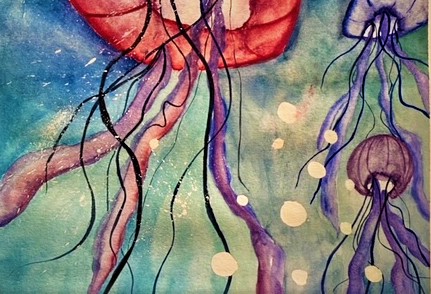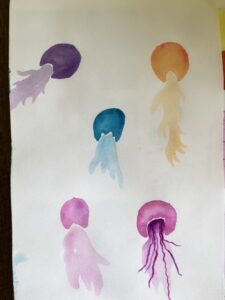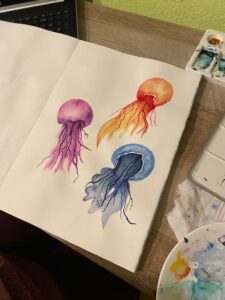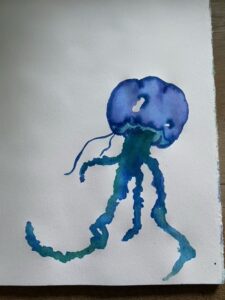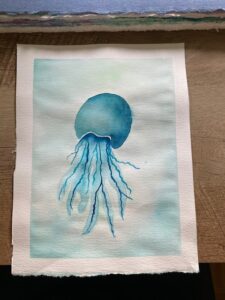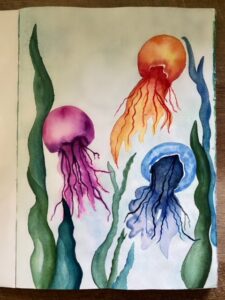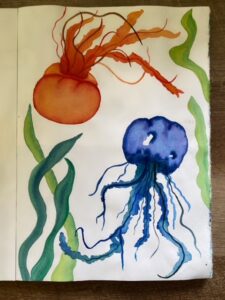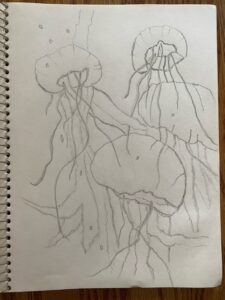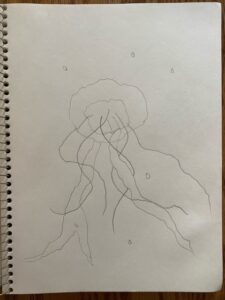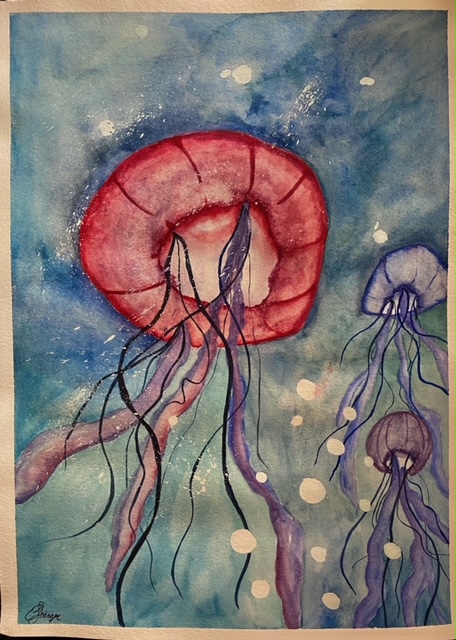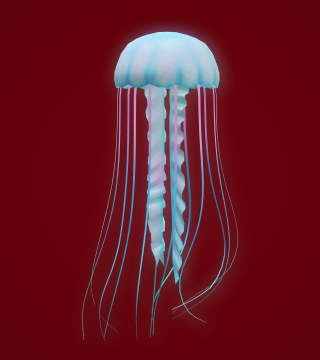
I have done my Artistic Inquiry Project on the Ocean with a specific focus on Jellyfish. I have always found Jellyfish very fascinating, along with all plants and creatures which reside in our ocean off the west coast. Over the past few months I have taken a keen interest in watercolor painting, partially inspired by this class and also by my mother, who is a very talented water colorist herself. I have broken my artistic inquiry into a few different sections, which you can find below.
Artistic Exploration
My Work-Space
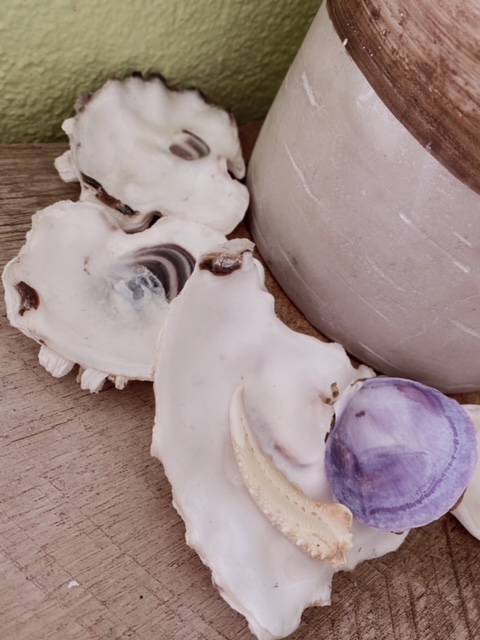 I am lucky enough to have a bedroom with four large windows which get morning and early afternoon sun, letting in lots of light for painting! I paint at my desk, and typically leave most of my paints etc. set up and laid out so I can easily sit down and paint or doodle away whenever I feel inspired. One of my favorite things to do is spend hours scouring the beach for interesting and unique oyster shells-you can see some of them on my desk.
I am lucky enough to have a bedroom with four large windows which get morning and early afternoon sun, letting in lots of light for painting! I paint at my desk, and typically leave most of my paints etc. set up and laid out so I can easily sit down and paint or doodle away whenever I feel inspired. One of my favorite things to do is spend hours scouring the beach for interesting and unique oyster shells-you can see some of them on my desk.

The Beginning
I have been painting and sketching several Jellyfish, all different sizes, styles and forms. Since deciding to do my artistic inquiry on Jellyfish, I have collected and taken photos of all my Jelly-related art.
Notes & Sketches
I have compiled all of my notes and rough sketches about and regarding Jellyfish.
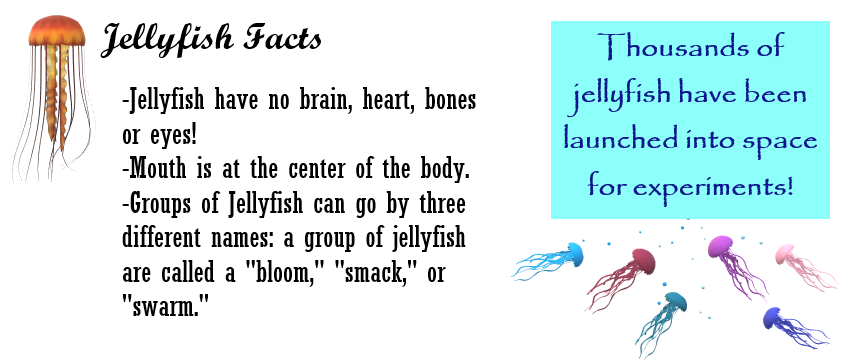
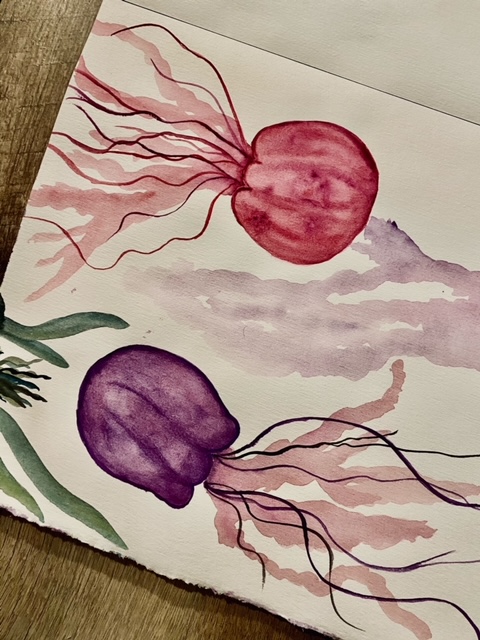
Jellyfish Questions & Answers!
- Where do they live? Jelly fish live in the ocean, and can live in any pa
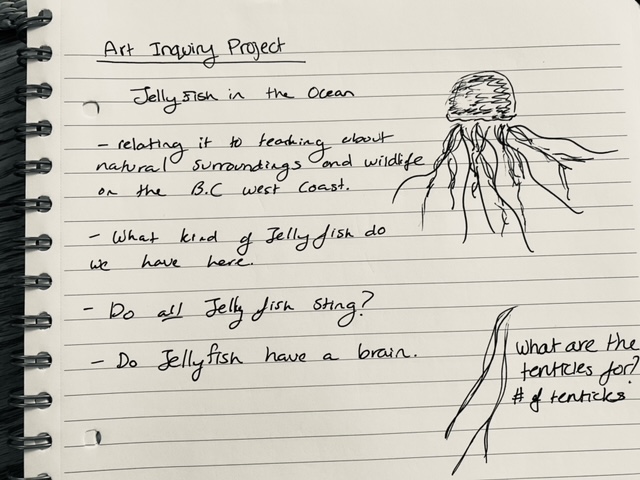 rt, warm or cold, deep or shallow.
rt, warm or cold, deep or shallow. - What is a threat to a Jellyfish? Predators include tunas, sharks, swordfish, sea turtles and penguins. Very few animals actually prey on Jellyfish, they are broadly considered to be a top predator in the food chain of the ocean.
- What do Jellyfish eat? Jellyfish can eat phytoplankton (small plants), fish eggs, small fish (larvae) and many other different kinds of marine creatures and animals. Some Jellyfish even eat other Jellyfish!
- How do they reproduce?

https://ocean.si.edu/sites/default/files/styles/photo_full/public/jellyfish-lifecycle-blue.jpg?itok=JL2qe0eC - How long do they live? On average, Jellyfish live 1 year or less. Some Jellyfish (the smallest ones) only live a few days!
- Colors? Jellyfish come in many different colors, some jellyfish are clear whereas others are very beautiful and colorful! They can be pink ,yellow, red, blue or purple and many of them are luminescent (they glow!).
- How do they move? Jellyfish swim bay contracting and then relaxing a ring of muscles around their ’round jelly part’. These muscles open and close this part of the jelly, pulling in water and then forcing it out, propelling the Jellyfish forward!
- Do they get tangled?! Jellyfish never get tangled! Even though some of them have extremely long tentacles, they never get tangled up or sting themselves! This is because the Jellyfish tentacles are very slippery and will only sting other Jellyfish and/or predators.
Lesson Plan Idea!
I have written up a *rough/loose* lesson plan outline for a jellyfish related art project which could be incorporated at the end of a watercolor unit. This lesson plan outline could be adapted to suite various grade levels and time allowance-meaning certain parts could be taken out or added to.

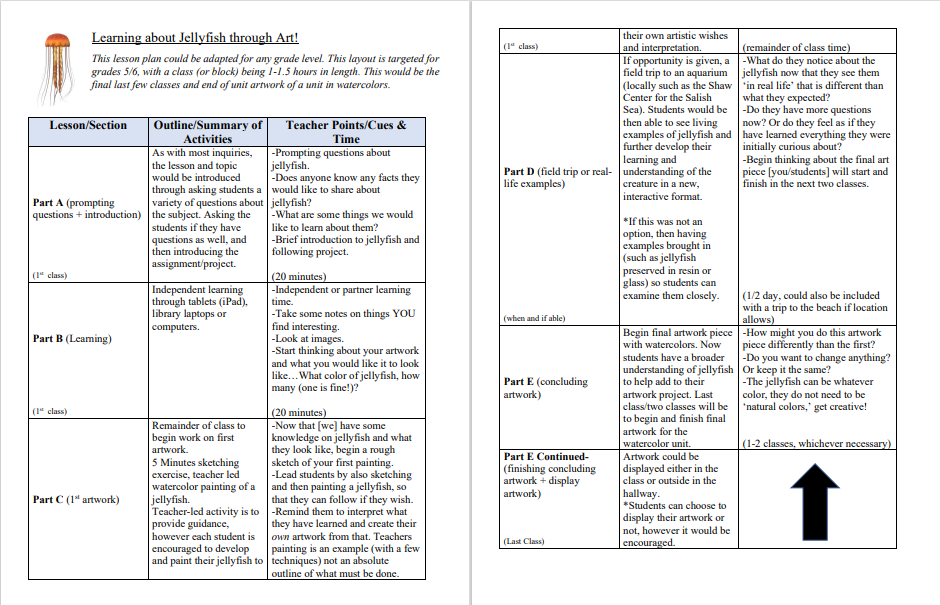
Final Artwork
Below are my final artwork pieces. One is my own, and one is my mother’s who has helped me with this process. Both paintings have been done using the “wet on wet” watercolor technique. I actually found this painting the most difficult, as I had not done any wet on wet yet, and it was a totally different ballgame so to speak! It took lots of patience on both my end and my dear mothers.
Relating to B.C. Curriculum
With regards to the B.C Art Curriculum and my inquiry project, I have found that it meets the following under “Content, Competencies & Big Ideas.”
CONTENT
Elements and Principles of Art: Shape, colour.
Image Development Strategies: Point of view, elaboration, embellishment.
Materials, Techniques & Processes & Vocabulary: Drawing and painting.
COMPETENCIES: Curricular & Core
Creative Processes (Curricular): Explore, create, reflect, document, connect.
Communicate (Core): Develop, acquire and transform ideas & information. Document work and ideas
Think (Core): Explore, reflect, connect.
BIG IDEAS
- Artistic Growth
- Artist Intentions
- Social & Cultural: Environment.
Rationale / Reflection
Rationale
The reason behind my project was to primarily learn how to paint Jellyfish using various water colour techniques as the inquiry was for an art class. However, I am also very curious about the creatures and have always had a keen interest in them, so this project also allowed me to pursue researching them more in depth on top of learning how to paint them.
Goals & Intentions:
- Complete Art Assignment #2, option B: Free Inquiry.
- Learn how to paint watercolor Jellyfish using various water colour techniques.
- Further my watercolor skills, which I began pursuing in January of this year (2021).
- Extend my knowledge on Jellyfish so that I may be able to understand them better and therefor make my paintings more in depth and meaningful.
Reflection
Reflecting on my Free Inquiry, I have discovered that I have not only learned what I set out to do: learn how to paint Jellyfish using various watercolor techniques while also learning about the animal to enhance my understanding and therefor painting, but also more. Once I began my inquiry project, I found myself very invested and enjoying it immensely. The questions and facts which I researched each independently, I found very interesting and only intensified my interest in my project. The lesson plan which I created for my own personal satisfaction, I enjoyed designing and coming up with various ideas on how to incorporate my inquiry and findings into a classroom. I also considered this good practice for making lesson plans in the future.
Paintings:
With regards to the actual paintings, I found the wet on dry technique the easiest and most enjoyable for painting Jellyfish. However, saying this, I used a bit of wet on wet for the inside of many of my Jellyfish to accomplish a blended look in their color. I painted many variations of Jellyfish, different colors, different shapes, different tentacle styles, different numbers (of Jelly’s in a painting-which I have learned it is always best to paint in odd numbers!) and different techniques. My last painting (my final artwork) I used the wet-on-wet technique for the entire painting with guidance from my mother, who is a talented watercolor artist with wet-on-wet being her area of specialty. I found the wet-on-wet technique the most difficult for painting the Jellyfish and it took the most patience, with this is mind I probably would not use this technique in a lesson plan unless the students were fairly comfortable with their watercolor skills. I am quite pleased with the painting portion of my inquiry, as I accomplished what I set out to do, which was “Learn how to paint watercolor Jellyfish using various water colour techniques” while also furthering my watercolor skills. If I were to do another inquiry (art related) I would challenge myself by using the wet-on-wet technique solely, if applicable to the project.
